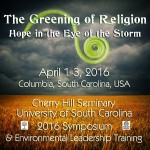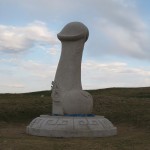This post comes from my presentation at the recent Greening of Religions conference organized by Cherry Hill Seminary.
According to Religious Studies scholar, Michael York, a “nature religion” is one which has “a this-worldly focus and deep reverence for the earth as something sacred and something to be cherished.” Many contemporary Pagan traditions and groups explicitly style themselves as “nature religions” or “earth religions,” and many individual Pagans describe their spirituality as “nature-centered” or “earth-centered.” And yet, the question of whether Paganism is a “nature religion” is a complex one.
Professor of Religious Studies, Sarah Pike, dates the origins of the American Neo-Pagan movement to the founding of Fred Adams’s Feraferia and the New Reformed Order of the Golden Dawn in 1967.[1] That same year, the Neo-Pagan Church of All Worlds also filed for incorporation, and the following year became the first state-recognized Neo-Pagan church. The founder of the Church of All Worlds, Oberon Zell, was the first to use the term “Pagan” to describe the loose community of spiritualities concerned with nature, magic, and polytheism, emerging at that time on the West Coast and elsewhere.[2] Not coincidentally, this was the same year that Lynn White’s provocative article, “The Historical Roots of Our Ecological Crisis,” appeared.[3]
Feraferia and the Church of All Worlds in particular styled themselves as nature religions. In 1970, the same year the first Earth Day was celebrated, Oberon Zell had a vision of Mother Earth as a living organism, several years before James Lovelock’s Gaia Hypothesis was popularized. Zell wrote:
“[I]t is a biological fact that all life on Earth comprises one single living organism! Literally, we are all ‘One.’ The blue whale and the redwood tree are not the largest living organisms on Earth; the entire planetary biosphere is.”[4]
The Church of All Worlds membership application required dedicants to commit to a way of life that is “ecologically sane,” and to pledge themselves to “harmonious eco-psychic awareness with the total biosphere of holy Mother Earth.”[5]
Similarly, Feraferia’s founder, Fred Adams described Feraferia as “a fellowship for the religion of nature and the commonwealth of wilderness.”[6]
Attempts at intra-Pagan ecumenicalism in the early years of the Neo-Pagan movement also produced statements which included commitments to ecology. The Council of Themis, organized by the Church of All Worlds, Feraferia, and other Pagan groups in 1972, issued a statement which read, in part,
“[E]cology shows the pattern of [humankind’s] proper and creative involvement with Nature, … Of all [humankind’s] secular studies, ecology comes closest to bringing [them] to the threshold of religious relationship to his world.”[7]
The following year, the short-lived Council of Earth Religions was formed by various Neo-Pagan groups. Then, in 1974, the Council of American Witches adopted a document titled “13 Principles of Wiccan Belief,” the second item of which declared:
“We recognize that our intelligence gives us a unique responsibility toward our environment. We seek to live in harmony with Nature, in ecological balance …”[8]
In the 1970′s Neo-Paganism intersected with the eco-feminism movement by way of feminist witchcraft. The late Morgan McFarland, the founder of a gender-inclusive form of Dianic Witchcraft, expressed a common sentiment of the time:
“A Pagan world view is one that says the Earth is the Great Mother and has been raped, pillaged, and plundered and must once again be celebrated if we are to survive. Paganism means a return to those values which see an ecologically balanced situation so that life continues and the Great Mother is venerated again. … Both ecology and Paganism seek a restoration of the balance of nature. If you’re not into ecology, you really can’t be into Paganism.”[9]
And yet, even in its first decades, not all Pagans understood Paganism as a nature religion. For some, like Fritz Muntean, one of the founders of the New Reformed Order of the Golden Dawn, Paganism was not primarily a nature religion, but rather a hedonistic religion, one centered on ethic of free and responsible self-expression.[10]
Nor were all early Pagans environmental activists. In the first edition of Drawing Down the Moon published in 1979, NPR correspondent and Wiccan priestess, Margot Adler, documented a worrying lack of political will among Neo-Pagans.[11] Later, in the 1986 edition of her book, Adler records one of the leaders in the Neo-Druidric movement, Isaac Bonewits, the founder of ADF, saying that while many Neo-Pagans were very concerned about environmental matters, “Most Neo-Pagans are too loose and liberal to be fanatic about anything, including their own survival.”[12]
Skipping ahead to today, many — but by no means all — contemporary Pagans continue to describe their spirituality as earth-centered or nature-centered. Many Pagans are pantheists or animists who perceive the divine as immanent in the physical world. The spirituality of many Pagans is focused on cultivating or restoring a sense of connection with nature.
The celebration of the Wheel of the Year, perhaps the most common contemporary Pagan ritual, which consists of eight holy days corresponding to the solstices and equinoxes and the mid-points in between, is an expression of this desire to connect with nature. In addition, many Pagans express their spirituality through gardening, composting, permaculture and other activities that promote sustainable living, as well as participation in direct political action against environmentally irresponsible actions of business, industry and government.
And yet, the relationship of contemporary Paganism with the natural world is not an uncomplicated one. Neo-Pagans have inherited ritual forms and theology from British Traditional Wicca, which did not itself begin as a nature religion, but as an esoteric mystery cult.[13] The resulting ritual and symbolic forms sometimes bear an ambiguous relationship to nature. Consider how Pagans living in myriads climatic zones may follow a universalist Wheel of the Year derived from the climate of Great Britain, which may or may not correspond with the local environmental conditions. As Dr. Jo Pearson has observed, the Pagan Wheel of the Year sometimes turns the seasons, rather than the other way around.[14]
Similarly, when Pagans invoke the “elements,” often in indoor settings, these may take the form of abstract Neo-Platonic essences, rather than the actual earth beneath our feet and the air and water flowing around us. Pagan Ritualist, Steven Posch, relates one instance, for example, when a Pagan group, invoked the element of water in the traditional cardinal direction of the west, while nearby the great Mississippi River flowed by unnoticed in the east.[15]
And as centerpiece of such a ritual, Pagans might undertake an imaginal “journey” to a grove or other sacred natural site to converse with spirits or deities — without ever having to experience the inconveniences and harsher realities of the natural world or appreciate directly the connection between our actions and their effect on the natural world.
Posch questions whether we Pagans, as we gather in our circles, are “standing with our backs to the world,” figuratively as well as literally.[16]
Notes:
[1] York, Michael. “Nature Religion as a Contemporary Sectarian Development.” DISKUS Volume 6 (2000).
[2] Sulak, John; Zell, Oberon; Glory, Morning. The Wizard and the Witch: Seven Decades of Counterculture, Magick & Paganism (2014); Cusack, Carole. “The Church of All Worlds and Pagan Ecotheology: Uncertain Boundaries and Unlimited Possibilities,” DISKUS Vol. 11 (2010). 
[3] https://www.uvm.edu/~gflomenh/ENV-NGO-PA395/articles/Lynn-White.pdf 
[4] G’Zell, Otter. “Theagenesis: The Birth of the Goddess.” First delivered in the form of a sermon to the congregation of the Church of All Worlds on September 11, 1970; subsequently published as the lead article in Green Egg “the journal of the Neo-Pagan movement” Vol. V, No. 40 (July 1, 1971); republished in the first issue of The Witches Broomstick magazine (Feb. 2, 1972); excerpted in Dr. Leo Louis Martello’s book, Witchcraft; The Old Religion (University Books, Inc. 1973); and delivered as a keynote lecture at the Third Annual Gnostic Aquarian Festival in Minneapolis, MN, Sept. 21, 1973. 
[5] Duplicate Membership Application (as presented in Green Egg Oimlec 1989).
[6] Adams, Fred. Korythalia. 
[7] Council of Themis, from Green Egg #43.
[8] The American Council of Witches. “13 Principles of Wiccan Belief” (1974).
[9] From Adler, Margot. Drawing Down the Moon: Witches, Druids, Goddess-Worshippers, and Other Pagans in America, 2nd ed. (1986). 
[10] Muntean, Fritz. “Are We Really a ‘Nature’ Religion?” (January 29, 2014) 
[11] Adler, Margot. Drawing Down the Moon: Witches, Druids, Goddess-Worshippers, and Other Pagans in America (1979). 
[12] Adler, Margot. Drawing Down the Moon: Witches, Druids, Goddess-Worshippers, and Other Pagans in America, 2nd ed. (1986). 
[13] Hanegraaff, Wouter J. New Age Religion and Western Culture: Esotericism in the Mirror of Secular Thought (1997); Pearson, Jo. “Demarcating the Field: Paganism, Wicca and Witchcraft,” DISKUS Volume 6 (2000).
[14] Pearson, Joanne. Nature Religion Today: Paganism in the Modern World (1998). 
[15] Personal communication, Pagan Spirit Gathering 2014. 
[16] Posch, Steven. “Standing with Our Backs to the World” (April 27, 2014).

















